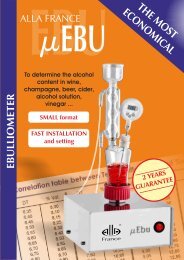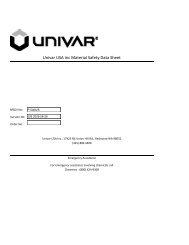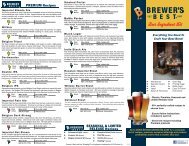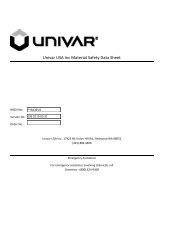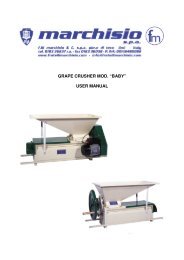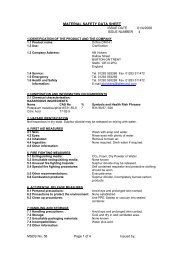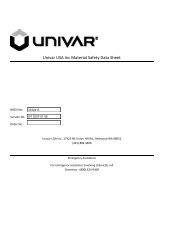MATERIAL SAFETY DATA SHEET - LD Carlson Co.
MATERIAL SAFETY DATA SHEET - LD Carlson Co.
MATERIAL SAFETY DATA SHEET - LD Carlson Co.
Create successful ePaper yourself
Turn your PDF publications into a flip-book with our unique Google optimized e-Paper software.
<strong>MATERIAL</strong> <strong>SAFETY</strong> <strong>DATA</strong> <strong>SHEET</strong><br />
Manufactured By:<br />
FIVE STAR CHEMICALS & SUPPLY, INC. Phone: 303-287-0186<br />
4915 E 52 ND Ave MSDS Date: 6-6-12<br />
<strong>Co</strong>mmerce City, CO 80022 Replaces: 12-15-10<br />
______________________________________________________________________________<br />
IDENTIFICATION<br />
PRODUCT NAME: STAR SAN<br />
COMPOSITION: Solution of Phosphoric Acid and Dodecylbenzene sulfonic acid.<br />
-------------------------------------------------------------------------------------------------------------------------------------------<br />
HAZARDOUS INGREDIENTS: % ACGIH TLV OSHA/PEL<br />
Phosphoric Acid (75%) (CAS# 7664-38-2) 50.0 1 mg/ m 1 mg/M3(TWA)<br />
Dodecylbenzene Sulfonic Acid (CAS# 27176-87-0) 15.0 N/A<br />
(Other compositional information is considered a trade secret).<br />
_________________________________________________________________________________________<br />
PHYSICAL <strong>DATA</strong><br />
APPEARANCE: Dark, amber liquid<br />
SOLUBILITY IN WATER: <strong>Co</strong>mplete<br />
ODOR: Slight SPECIFIC GRAVITY: 1.32<br />
pH OF CONCENTRATE: 1<br />
FLASH POINT: TCC 121 deg F<br />
EVAPORATION RATE: .9 (water=1)<br />
__________________________________________________________________________________________<br />
FLAMMABILITY:<br />
EXTINGUISHING MEDIA:<br />
UNUSUAL FIRE AND<br />
EXPLOSION HAZARDS:<br />
FIRE AND EXPLOSION <strong>DATA</strong><br />
TCC-121 deg F<br />
Water, Carbon Dioxide, Foam<br />
<strong>Co</strong>ntact with metals may evolve flammable hydrogen gas. <strong>Co</strong>ntainers<br />
may explode when heated. <strong>Co</strong>ntact with chlorine will evolve chlorine<br />
gas.<br />
NFPA HAZARD RATING: Health 3; Flammability 0; Reactivity 1<br />
__________________________________________________________________________________________<br />
HEALTH HAZARD <strong>DATA</strong><br />
- EYE CONTACT: <strong>Co</strong>rrosive to the eyes may cause severe damage.<br />
- INHALATION: Irritating to the nose , throat, and respiratory tract.<br />
- INGESTION: Harmful if swallowed. Swallowing product can cause sever burns to lining of throat and<br />
stomach<br />
- SKIN CONTACT: Substance is corrosive. Causes severe skin burns.<br />
- SIGNS AND SYMPTOMS OF EXPOSURE: Destruction to skin and eye tissue<br />
- SUPPLEMENTAL HEALTH INFORMATION: NOTE TO PHYSICIAN: Probable mucosal damage may<br />
contraindicate the use of gastric lavage. Measures against circulatory shock, reparatory depression and convulsions<br />
may be needed.<br />
__________________________________________________________________________________________<br />
EMERGENCY & FIRST AID PROCEDURES<br />
EYE CONTACT:<br />
SKIN CONTACT:<br />
INGESTION:<br />
INHALATION:<br />
Flush with cool running water for at least 15 minutes. For eye exposure irrigate with<br />
saline solution Get medical attention as soon as possible.<br />
Flush with cool running water. If irritation develops get medical attention.<br />
If conscious, give several glasses of milk, water, egg whites or gelatin solution. Get<br />
medical attention immediately. DO NOT induce vomiting.<br />
Move victim to fresh air. Call emergency medical care. Apply artificial respiration if<br />
victim is not breathing.
Page 2<br />
Star San<br />
SPECIAL PROTECTION INFORMATION<br />
RESPIRATORY PROTECTION: Atmospheric levels should be maintained below the exposure limits<br />
Listed in Hazardous Ingredients by using engineering controls. If not feasible,<br />
Use approved full face piece air-purifying respirator.<br />
VENTILATION SYSTEM: Provide general and/or local exhaust ventilation to maintain airborne<br />
levels below the exposure limits in Hazardous Ingredients. Refer to “Industrial<br />
Ventilation” by ACGIH for a manual of recommended practices.<br />
SKIN PROTECTION:<br />
If skin or contamination of clothing is likely, protective clothing should be worn.<br />
EYE PROTECTION:<br />
Chemical goggles are required.<br />
PROTECTIVE GLOVES: Wear chemical resistant gloves.<br />
__________________________________________________________________________________________<br />
REACTIVITY <strong>DATA</strong><br />
INCOMPATIBLE <strong>MATERIAL</strong>S: Alkalis, chlorinated products, and soft metals.<br />
STABILITY:<br />
Product is stable.<br />
POLYMERIZATION:<br />
Will not occur.<br />
DECOMPOSITION PRODUCTS: May give off phosphorous oxide at high heat (fire conditions).<br />
__________________________________________________________________________________________<br />
SPILL OR LEAK PROCEDURES<br />
SPILL:<br />
DISPOSAL:<br />
See Emergency/ First Aid Procedures and Special Protection Information for hazards and<br />
exposure controls. Dike with sand or earth to contain spill. Avoid ignition sources.<br />
Absorb with sand to other non-flammable material and transfer to approve DOT drum for<br />
recovery or disposal.<br />
Dispose of in accordance with local, state and federal regulations.<br />
GENERAL:<br />
CERCLA/SARA requires notification to the appropriate Federal state and local<br />
authorities of releases of hazardous or extremely hazardous quantities equal to or greater<br />
than the Reportable Quantities (RQs) in 50 CFR 302.4 and 40 CFR 355.<br />
SARA Title 313 requires submissions of annual reports of releases of toxic chemicals<br />
that appear in 40 CFR 372. <strong>Co</strong>mponents present in this product at a level which could<br />
require reporting under statute are listed under identification.<br />
_________________________________________________________________________________________<br />
TRANSPORTATION<br />
DOT HAZARD CLASSIFICATION:<br />
<strong>Co</strong>rrosive Liquid N.O.S.<br />
(<strong>Co</strong>ntains Phosphoric Acid and Dodecylbenzensulfonic Acid)<br />
8, UN1760, PG III<br />
US DOT LABEL: <strong>Co</strong>rrosive Liquid, UN 1760, Class 8<br />
LABEL REQUIRED:<br />
<strong>Co</strong>rrosive Liquid, Class 8 Label as required by OSHA Hazard<br />
<strong>Co</strong>mmunication Standard, and any applicable state and local<br />
regulations.<br />
EMERGENCY TELEPHONE: INFOTRAC 800-535-5053



